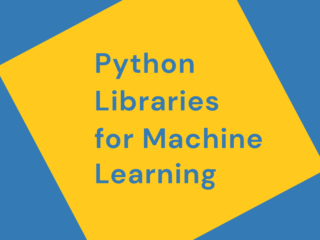Python Libraries for Data Engineers – Guide
Data, data, and some more data. As businesses are swimming in the ocean of information, data engineers have become the lifeguards with their trusty flotation device — Python.
Python is a versatile language that quickly becomes the go-to tool for data wizards everywhere. Why?
It’s simple enough for beginners yet powerful enough to tackle the most complex data challenges. But Python’s real superpower lies in its vast ecosystem of libraries.
If you’re a data engineer, developer, or anyone looking to optimize their data engineering processes using Python, let us introduce you to the key Python libraries that will make your life a whole lot easier.
Pandas
Want a personal assistant who can organize, clean, and analyze your data in the blink of an eye? That’s Pandas for you.
This library is a powerhouse of data manipulation and analysis in Python. It will turn your messy datasets into well-behaved tables faster than you can say “spreadsheet.”
Key features:
- DataFrame and Series data structures for efficient data handling
- Powerful data alignment and integrated indexing
- Tools for reading and writing data between in-memory data structures and various file formats
- Intelligent data alignment and missing data handling
Real-world applications:
- Cleaning and preprocessing large datasets
- Time series analysis and financial data modeling
- Creating data pipelines for ETL (Extract, Transform, Load) processes
- Ad-hoc data analysis and exploration
NumPy
NumPy is fundamental for scientific computing in Python. It provides support for large, multi-dimensional arrays and matrices, along with a collection of mathematical functions to operate on these arrays.
Key features:
- Efficient multi-dimensional array object
- Broadcasting functions for performing operations on arrays
- Tools for integrating C/C++ and Fortran code
- Linear algebra, Fourier transform, and random number capabilities
Real-world applications
- Implementing machine learning algorithms
- Signal and image processing
- Financial modeling and risk analysis
- Scientific simulations and computations
PySpark
When your data gets too big, PySpark steps in, it’s the Python API for Apache Spark that enables big data processing and distributed computing at scale.
Key features:
- Distributed data processing with Resilient Distributed Datasets (RDDs)
- SQL and DataFrames for structured data processing
- MLib for distributed machine learning
- GraphX for graph computation
Real-world applications:
- Processing and analyzing large-scale log files
- Real-time data streaming and analysis
- Building and deploying machine learning pipelines on big data
- Graph processing for social network analysis
Dask
Dask brings the power of multicore and distributed parallel execution for analytics to enable performance at scale for large datasets and computations.
Key features:
- Parallel computing through task scheduling
- Scaled pandas DataFrames
- Integrations with existing Python libraries
- Dynamix task graphs for complex workflows
Real-world applications:
- Scaling existing pandas, NumPy, and scikit-learn workflow
- Processing datasets larger than memory
- Parallel and distributed machine learning
- Interactive data analysis on large datasets
SQLAlchemy
SQLAlchemy is a SQL toolkit and Object-Relational Mapping (ORM) library that provides a full suite of well-known enterprise level persistence patterns.
Key features:
- Efficient and high-performing database access
- Database schema creation, manipulation, and querying
- ORM for translating Python classes to database tables
- MSupport for multiple database systems
Real-world applications:
- Building database-backed applications
- Creating and managing complex database schemas
- Implementing data warehousing solutions
- Automating database migrations and versioning
Lxml
At a glance, XML looks like alphabet soup, but Lxml knows how to make sense of it all. It’s fast, it’s powerful, and it makes XML processing a breeze.
Key features:
- Fast XML parsing and generation
- Support for XPath and XSLT
- Pythonic API for tree traversal and manipulation
- Validation against DTDs and XML schema
Real-world applications:
- Parsing and processing XML-based data feeds
- Web scraping and HTML parsing
- Generating XML reports and documents
- Integrating with XML-based APIs and services
For more detailed information on XML processing with Python, you can refer to this post on XML conversion using Python from Sonra.
Why is Python ideal for data engineering?
So, why has Python become the darling of data engineers everywhere? It’s not just because of its cool name (though that doesn’t hurt).
The real reason is its versatility, which allows engineers to tackle diverse tasks within a single ecosystem, from data extraction and transformation to analysis and visualization.
Python has a straightforward syntax and is a very readable language. It reduces the learning curve for a beginner.
Despite being easy to use, Python offers a powerful and compelling ecosystem of libraries. For data engineers, it’s like having a toolbox where every tool is your favorite. Need to crunch numbers? There’s a library for that. Want to automate workflows? Done.
And let’s not forget about Python’s amazing community. It’s huge and helpful. If you’re facing a problem, chances are someone in the Python community has already solved it and shared the solution.
Automating data engineering tasks with Python
In the past decade, the use of Python has significantly increased due to its capability to automate boring stuff. Python is well able to streamline complex data workflows and increase productivity.
Data engineers use libraries like Apache Airflow and Perfect to approach task scheduling and pipeline management. These tools allow for the creation of dynamic, scalable, and maintainable data pipelines using Python code.
With Airflow, you can create data workflows that look like flowcharts (called Directed Acyclic Graphs or DAG). It is used for complex ETL processes. Prefect takes things up a notch, offering even more flexibility and observability.
Want to learn more?
Hungry for more Python goodness? Check out these articles:
Conclusion
The Python libraries we discussed in the article form the backbone of modern data engineering practices. It offers powerful tools to tackle complex data challenges efficiently.
Data engineers can use these libraries to streamline workflows, improve data processing capabilities, and build strong and scalable data pipelines.
If you’re a data engineer, we’ll encourage you to be more interested in Python libraries. Play around, experiment, and see how they can transform your data engineering projects.
Remember, Python is not a language of the past; it’s a language of the future. The more you fall in love with this, the more you’ll be able to conquer those complex and large datasets that are yet to come.
Pandas Visualization

Code snippet: Importing Pandas for plotting
import pandas as pd
import matplotlib.pyplot as plt
df = pd.read_csv('data.csv')
df.plot(kind = 'scatter', x = 'Duration', y = 'Maxpulse')
plt.show() PySpark Visualization

Code snippet: # How many passengers tipped by various amounts
# Look at a histogram of tips by count by using Matplotlib
ax1 = sampled_taxi_pd_df['tipAmount'].plot(kind='hist', bins=25, facecolor='lightblue')
ax1.set_title('Tip amount distribution')
ax1.set_xlabel('Tip Amount ($)')
ax1.set_ylabel('Counts')
plt.suptitle('')
plt.show()





